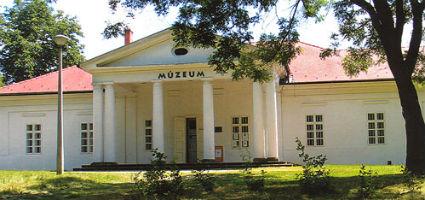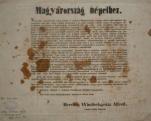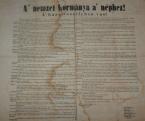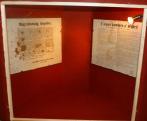2024. May 6. Monday
Pál Kiss Museum - Tiszafüred
 |
Address: 5350, Tiszafüred Tariczky sétány 6.
Phone number: (59) 352-106
E-mail: kisspalmuz@gmail.com
Opening hours: Tue-Sat 9-12, 13-17
|
The exhibition has closed for visitors.
2015.03.02. - 2015.03.31.
Museum tickets, service costs:
|
Ticket for adults
|
500 HUF
|
/ capita
|
|
Group ticket for adults
(min. 10 people)
|
150 HUF
|
/ capita
|
|
Ticket for students
|
250 HUF
|
/ capita
|
|
Ticket for pensioners
|
250 HUF
|
/ capita
|
|
Ticket for families
(2 adults + max. 3 children)
|
750 HUF
|
/ family
|
|
Program ticket
|
300 HUF
|
/ capita
|
|
Season ticket
|
1000 HUF
|
|
|
Group guide
(max. 40 people)
|
2000 HUF
|
/ group
|
|
Photography
|
1000 HUF
|
|
|
Video
|
1000 HUF
|
This month we show two prints from our collection. Both are proclamations concerning the Hungarian revolution and war of independence in 1848-1849. It is well-known that the revolution of 1848 grew into a war of independence when the Habsburg imperial army attacted the Kingdom of Hungary in the early autumn of 1948. The first print is a proclamation of Prince Alfred Windisch-Graetz general and chief commander of the Habsburg imperial army. He declared that Kossuth Lajos and his followed were lowbreakers, because they turned against the Habsburg-monarchy. This print was issued on 29th December, 1848 in Győr (west of Budapest) and a few days later the imperial army occupied the Hungarian capital, Pest-Buda (it was the former name of Budapest).

A few months later, in spring of 1849 the main Hungarian army forced the Austrian troops back to the Austro-Hungarian frontier hammering them at Hatvan, Tápióbicske, Isaszeg, Vác, Nagysalló, Komárom and other towns along the way of the Spring Offense.
Then the Habsburg Emperor asked the Russion Tzar and the Tzar sent 200.000 soldiers to put down the Hungarian indepencence. In June, 1849, a joint Austrian-Russian offensive began.
The second print, a proclamation was issued at the end of June beginning with the words: „The homeland is in Danger”. The proclamation ended with a warning: „ Stand to, Stand to, the Homeland calls” signed by Kossuth Lajos, the Governor of Hungarian Kingdom and by his ministers.

A few months later, in spring of 1849 the main Hungarian army forced the Austrian troops back to the Austro-Hungarian frontier hammering them at Hatvan, Tápióbicske, Isaszeg, Vác, Nagysalló, Komárom and other towns along the way of the Spring Offense.
Then the Habsburg Emperor asked the Russion Tzar and the Tzar sent 200.000 soldiers to put down the Hungarian indepencence. In June, 1849, a joint Austrian-Russian offensive began.
The second print, a proclamation was issued at the end of June beginning with the words: „The homeland is in Danger”. The proclamation ended with a warning: „ Stand to, Stand to, the Homeland calls” signed by Kossuth Lajos, the Governor of Hungarian Kingdom and by his ministers.


